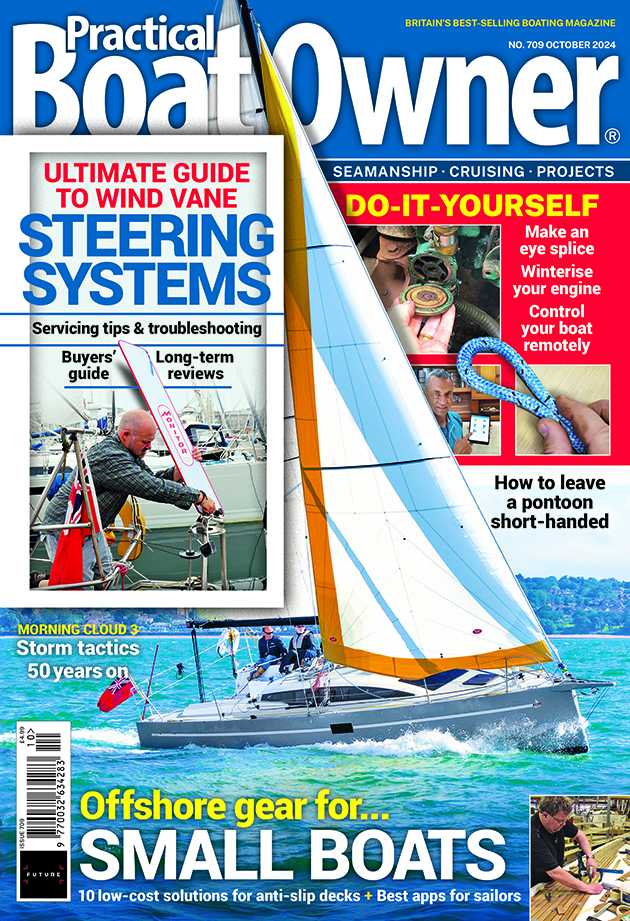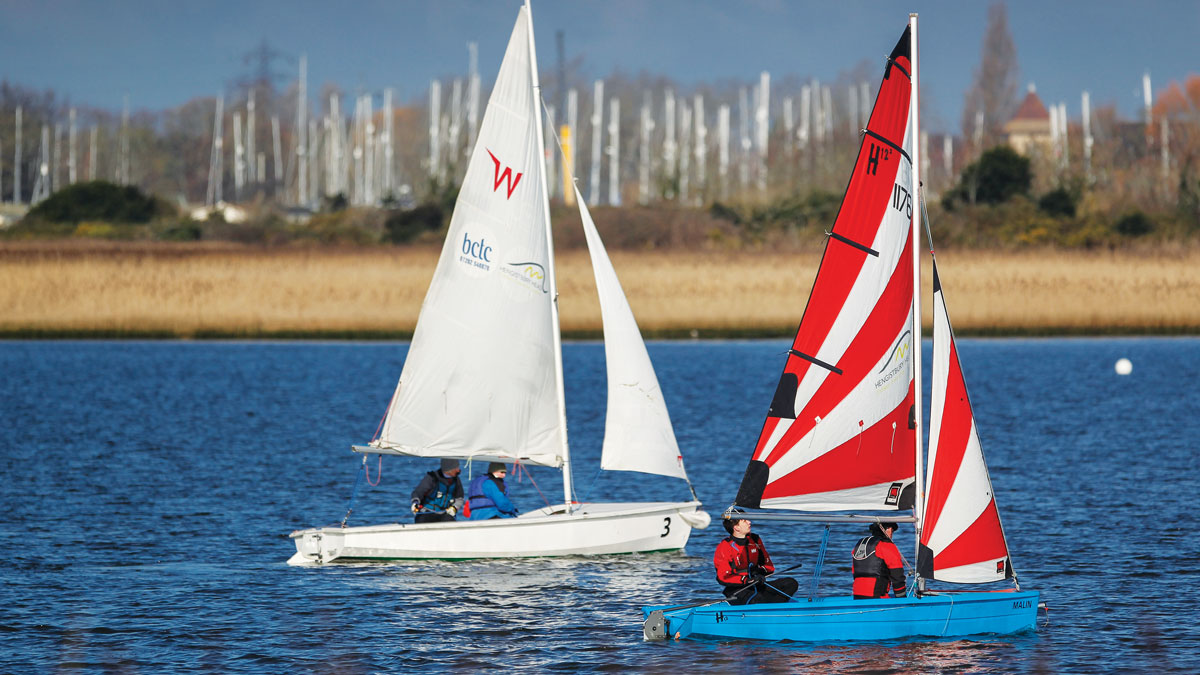For low cost traditionally-styled GRP trailer-sailers, consider the Foreland and the Otter available at bargain basement prices
Looking at the prices of good quality traditionally-styled GRP sailing dinghies recently I noticed that it was easy to spend well over £20,000 on a good one.
While the standard of finish of these top models is superb it’s still possible to buy old lesser-known GRP boats made 30 or 40 years ago that are in excellent condition for just a few hundred pounds.
Often, they have been languishing in garages for decades unused by their owners.
One such boat is the Foreland sailing dinghy. I came across my Foreland in online new and used boat sales pages and I travelled across to Hampshire to take a closer look.
Tucked up in a garage under sheets, she was owned by the skipper of a South Coast ferry and pleasure boat.
He’d sailed the Foreland dinghy now and then but had little time for her and being on the water all day he tended to spend his leisure time ashore.
Being ex-Merchant Navy like me we had plenty to natter about, and it was some hours before I eventually trailed my new little boat away.

Cheap dinghies: Note the Foreland’s high daggerboard case which would aid bailing after a capsize
She’s a most attractive traditionally styled dinghy: good for sailing, rowing or motoring with a small outboard clamped onto the transom.
The GRP hull is smooth which has certain advantages when launching and recovering onto your trailer because clinker-type hulls can get caught and damaged by the edge of a roller if not carefully aligned.
Smooth hulls are less prone to this. She has a good strong tow eye for recovery.
The Foreland dinghy was made by Foreland Marine of Folkestone about 40 years ago.
My model had an overall length of 10ft 6in and they also made a 12ft 6in version. To my eye, the 10ft 6in boat has better lines.
She has a wooden mast and spars and is very well fitted out in hardwood.
She has a gunter rig and light blue sails made by Rockall. I particularly like a gunter rig since it enables the mast to be stowed inside the hull when towing.
She has a good-sized skeg and this enables her to keep a good line while rowing from either of her two rowing positions.
Buoyancy is provided by built-in tanks forward and aft and small side tanks.

Cheap dinghies: Clive’s Otter dinghy ready to launch
The rudder is a lifting type and she uses a daggerboard which is my preference on shingle beaches.
The daggerboard case is fairly high, which might be useful when bailing after a capsize.
However, I’ve never got anywhere near to a capsize – she is stable and in any case, I avoid them like the plague.
I found her very predictable and responsive to sail and would take her out to sea from Rye along the Camber coast and also towards Fairlight.
She coped well with a little chop and was a good sailboat. Coming back into the narrow river against an early ebb was easy enough without the use of the motor and she tacked easily and pointed well.
The Rother is very narrow and may require multiple tacks in places.
Dodging the trawlers and avoiding other commercial vessels was easy work for the nifty little Foreland on her way to the ancient town of Rye for a coffee.
Such a lot of fun and independence for just a few hundred pounds!
Recently I searched online for a Foreland and saw one for just £350 and also a motor version with a foredeck.

Clive sailing his Foreland at Rye
When the time came to get more space in the yard I sold her to a couple who’d recently lost their Foreland and were looking for another – nothing else would do for them.
Another good low-cost sailboat is the Otter dinghy.
An early GRP boat, she is not as classic looking as the Foreland but still an attractive boat that sails very well.
Designed by G O’Brien Kennedy as a one-design GRP dinghy more than 50 years ago, these boats are regularly on the market because more than 1,000 were built. I came across mine tucked away on a farm just a mile down the lane from where I live.
They are Bermudan rigged with main, jib and spinnaker. Some are gunter rigged.
Otters are suitable for both cruising and racing and are capable of high performance. I found her to be very good upwind compared to most of my boats.
The aluminium mast is about 17ft 2½in (5.30m) long although some Otters have two-part aluminium masts or shorter masts for a gunter rig.
Otters are 11ft 11in (3.63m) in overall length with a 4ft 10in (1.47m) beam and a draught of 3ft 6in (1.07m) with the wooden centreboard down.

Dinghy Cruising Association member Tom Edom’s Otter dinghy. Credit: Tom Edom
They weigh just 165lb (75kg) which is nice and light for a nearly 12ft boat, making recovery easier.
The wooden centreboard, while not ideal for a shingle beach, has many advantages.
I trailed this Otter to various locations along the South Coast but eventually tried out an Otter with a two-part mast which I thought would be easier for trailing.
I bought the new-to-me boat from a man about 100 miles away. It was not a complete success!
I always check the trailer wheel bearings before towing, but it was raining and the owner assured me the bearings were fine. So, I towed it away.
Just 15 miles into the 100-mile trip there was a rumble and I could see that the offside wheel bearing was shot.
It was now dark and raining heavily, I had no torch and changing it on the roadside would be dangerous so I let things cool down and proceeded gingerly to a safe place.
Once home I lifted the trailer hitch from the tow ball and the hitch came off in my hand.
There were no visible external signs of corrosion but the bolts had rusted right through from the inside and I have no idea how they held together on the journey home.
I chucked the trailer and got a decent one. Never trust a second-hand trailer unless a competent person has checked it.
Looking forward to more trailer sailing and the ease of having a two-part mast I was soon disappointed when I found out that assembling the two parts and threading ropes and wires all over the place took forever – I wanted to be able to launch in minutes not hours.
So I sold that boat with its new trailer to a chap who’d be keeping its mast up in the club boat park.
But don’t let my foibles regarding two-part masts put you off buying an Otter for they are excellent little boats suitable for both dinghy cruising and racing.
So there we have it, you can get afloat in a good boat for a fraction of the price of other good quality traditionally-styled GRP sailing dinghies – just look out for your bearings.
Foreland 10
Original builder dimensions are not available but Clive has measured the. Foreland 10’s sizes to be:
LOA: 10ft 2in (3.10m)
Beam: 4ft 10in (1.47m)
Sail area: 58ft2 (5.39m2) gunter mainsail and jib
Draught: 5in (12cm) min, 2ft 3in (69cm) max
Weight: 198lb (90kg) with gunter rig
Otter dinghy
LOA: 11ft 11in (3.63m)
Beam: 4ft 10in (1.47m)
Displacement: 165 lb/75 kg
Rig: gunter or Bermudan
Sail area: 75ft² (6.97m²)
Max draught: 3ft 6in (1.07m)
Construction: glassfibre
Built: 1965-1988
Number built: 1,173
Designer: George O’Brien Kennedy
Hastings Boats: stable and seaworthy dinghies
The smaller Hastings luggers (22ft or less) are called punts – and Clive Marsh has converted several 16ft versions back…
Cruising dinghies for timeless adventures
Trailer-sailers can be stored at home, may not need a motor and can provide cosy accommodation with clever use of…
Dinghy sailing skills for cruisers
What can a lapsed cruising sailor learn from a dinghy course? A lot, as Ali Wood discovers when she returns…
Dinghy launch trolley renovation: make it look as good as new!
Rather than bin a rusty dinghy launch trolley, Alec Marsh saves cash - and landfill - and repairs it
Enjoy reading Seaworthy, cheap dinghies for less than £500?

A subscription to Practical Boat Owner magazine costs around 40% less than the cover price.
Print and digital editions are available through Magazines Direct – where you can also find the latest deals.
PBO is packed with information to help you get the most from boat ownership – whether sail or power.
-
-
-
- Take your DIY skills to the next level with trusted advice on boat maintenance and repairs
- Impartial in-depth gear reviews
- Practical cruising tips for making the most of your time afloat
-
-
Follow us on Facebook, Instagram, TikTok and Twitter








